► New Lotus Eletre electric SUV revealed
► 603bhp or 905bhp, 112kWh battery
► On sale in 2023, from £89,500 in the UK
Lotus has announced prices and specs for its Eletre electric SUV. Prices start from £89,500 in the UK and €95,990 in Europe.
If the Emira, Norfolk’s new and selling-like-hot-cakes two-seat sports car, was the easiest sell in Lotus history then this might be the hardest: a huge, heavy and complex SUV from a brand almost entirely synonymous with small, lightweight and simple sports cars.
What’s more, because Lotus isn’t interested in halfway-house hybridisation, the new Eletre is an EV. Yep, this new Lotus – a Lotus unlike any other – might have the proportions and the pace of a Lamborghini Urus, but its tailpipe emissions are precisely zero.
Read on for full details of the new Lotus Eletre range.
Lotus Eletre: the line-up and prices
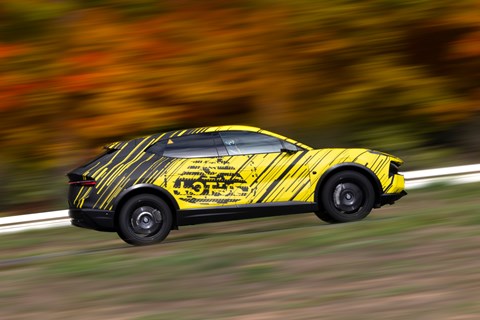
There are three variants: the Eletre, Eletre S and Eletre R. The R is claimed by Lotus to be the world’s fastest dual-motor production SUV.
In the UK, the Eletre starts from £89,500, the Eletre S from £104,500 and the Eletre R from £120,000.
There’s a choice of two power outputs: 450kW (603bhp) in the Eletre and Eletre S, or 675kW (905bhp) in the R. Both are dual-motor configurations, but the former has a single-speed transmission and the latter has a dual-speed transmission, allowing for faster acceleration.
Standard equipment across all versions includes air suspension, matrix headlights and 22-inch wheels (20s and 23s are available, across five wheel designs). Inside, all versions have wireless phone charging, 12-way adjustable front seats and four-zone climate control. Five seats are standard; four an option with the Executive Seat Pack.
A five-year/100,000-mile warranty is standard in the UK.
How fast is the Lotus Eletre R?
Its 0-62mph time is 2.95sec, compared with 4.5sec for single-speed versions, and its top speed is 165mph to the Eletre and Eletre S’s 160mph.
The R has a lower ride height and racier settings for both the dampers and anti-roll control, plus softer tyres fitted as standard to its gloss-black wheels. With the Track driving mode selected, its active grille opens further and a Launch Control function is enabled.
Can we back up a little? A Lotus SUV – why?
Lotus has been owned by Geely since 2017, the Chinese giant having identified the Norfolkian sports car maker as a Ferrari or Porsche beater in waiting. Just as Aston Martin – under new and ambitious management – now has Maranello in its sights, so too does a Lotus unrecognisable as the niche sports car maker that for years bumped along on the brink of financial oblivion.
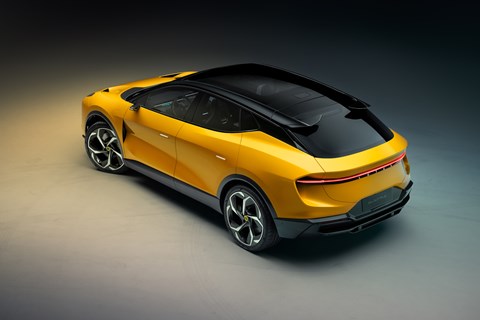
Lotus electric plans explained
Steered by Matt Windle, Lotus has been busy spending a lot of money. A return on that investment was always part of the plan, of course, and after the Evija electric hypercar and the Emira, New Lotus is backing the safest horse imaginable: an electric SUV. The Eletre represents myriad firsts for Lotus, not least being pitched squarely at the global premium mainstream. (A Taycan-style four-door coupe/saloon and smaller SUV will follow in the next couple of years, and, in China, Lotus has 150,000-units-per-year manufacturing capacity on standby to build these three EVs.)
What’s under the skin?
A dedicated new electric platform that, following standard EV procedure, slings a big slab-style 112kWh battery for a range of 373 WLTP-rated miles (or 304 miles in the R, on 20-inch wheels) between twin e-motors, one per axle. Given perfect all-wheel-drive traction and instant, stepless e-power, acceleration is predictably shattering, with this two-tonne car able to fire 0-62mph in less than 3.0sec in R trim.
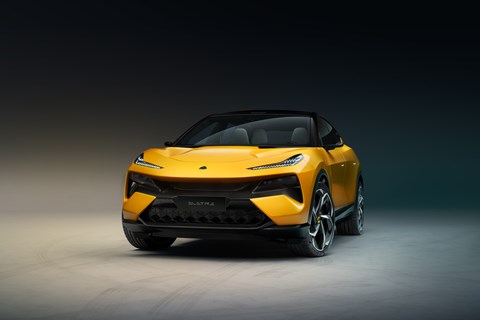
Air springs and adaptive damping are standard equipment, but the options list will includes clever chassis tech – tech the development team, under Gavan Kershaw, has been tuning at locations including the Nürburgring in the hope of making the Eletre the new dynamic benchmark on planet EV. (Lotus has benchmarked the Taycan, which is aiming admirably high given the Porsche’s far more helpful weight distribution.)
To look at, It’s not quite the 4×4 Evija we were expecting, is it?
Yes and no. CAR published a scoop story on the Eletre, known then only by its Type code: 132. Sources close to the project revealed that the SUV’s design would borrow heavily from the Russell Carr-penned Evija hypercar. Perhaps predictably, the finished car isn’t quite as dramatic as the two-seat hypercar. But it’s a world away from the blunt boxiness of SUVs like the Rolls Cullinan and Bentley’s four-square Bentayga.
‘Everything Lotus has done for the last 30 years or so has been mid-engined,’ explains Eletre lead designer and Lotus studio director Ben Payne. ‘While this is obviously a totally different kind of product, we wanted to reference that mid-engined heritage, so that subconsciously you understand the car. These proportions also underline the fact that this is electric – we don’t have the long bonnet of, say, Aston Martin’s DBX. The ground-up new platform goes hand-in-hand with the mid-engined silhouette, and electrification has allowed us to achieve this.’
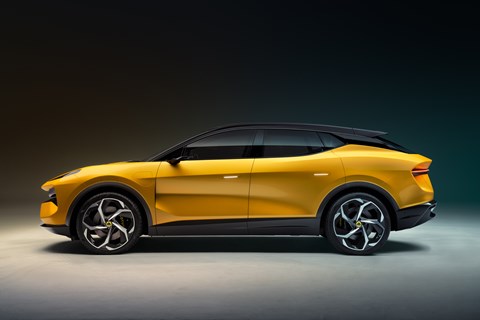
CAR talks to Lotus boss, Matt Windle
The 23-inch wheels help shrink the car (they help a lot, in truth), and there are shades of Evija in this mix. Where that car has a glazed bubble cockpit, the Eletre has the SUV equivalents: a sleek, raked windscreen and a panoramic roof which appears to float. There’s also a frankly astonishing amount of sculpture in the car’s flanks; far more than you’ll find on any other SUV.
‘The proportions, the surfacing – we’re taking the kind of ideas you normally find on really aggressive sports cars and even hypercars and applying them to an SUV,’ says Payne. ‘This helps reduce the volume of the product: we’re literally removing mass by carving holes in the car. It also creates a super-dynamic form with more extreme sculpture than anything else in its class.’
What about inside?
Just as you’re starting to get your head around an electric SUV from Lotus, you catch sight of the interior – and your mind is blown.
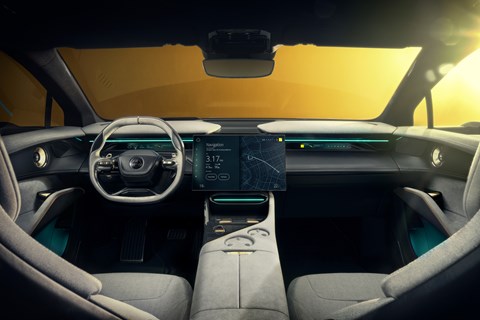
And it is gorgeous – as driver-focused as you’d expect of a Lotus (the small-diameter steering wheel in particular, with its regen-adjust and drive mode paddles, is lovely) but sparkling with the kind of bleeding-edge technology (big, crisp OLED screens and advanced semi-autonomous driver-assist systems) Old Lotus could only dream of.
Sitting behind the wheel, the bespoke driver’s display is a super-slim strip, reminiscent of the McLaren 720S’s binnacle when you fold it down in minimalist Race mode. ‘That strip, together with the head-up display, delivers your primary functions,’ explains designer Payne. ‘For everything else there’s the 15.1-inch OLED touchscreen. It’s the size of a decent laptop screen, so fantastically usable, but if you just want to drive it can back off into the dash, leaving you looking ahead, hands on the wheel, no distractions. That’s very Lotus. To the same end, while you can adjust temperature and fan speed on the touchscreen, we also have physical buttons.’
The Eletre is fitted with Lotus’s new Hyper OS operating system for driver and passengers, geared for over-the-air updates.
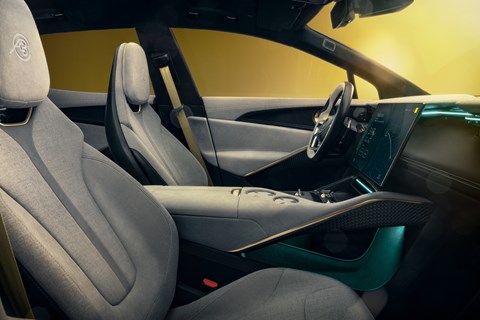
Thanks to the dedicated platform beneath this is also an astonishingly roomy interior: rear-seat legroom is more limo than Lotus.
Arguably 2022’s bravest new car, the Eletre leapfrogs combustion-engined performance SUVs like the Aston DBX and Ferrari Purosangue to establish a Lotus foothold in a potentially hugely lucrative market. The lack of petrol power will hold it back in some regions, no doubt. But it’ll be a considerable advantage in many others, and for a car at odds with so many Lotus virtues in so many ways, the Eletre is at least boldly innovative – and that’s perhaps the most important Lotus value of all.